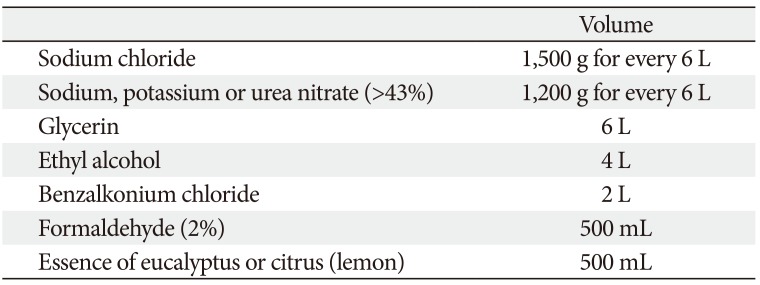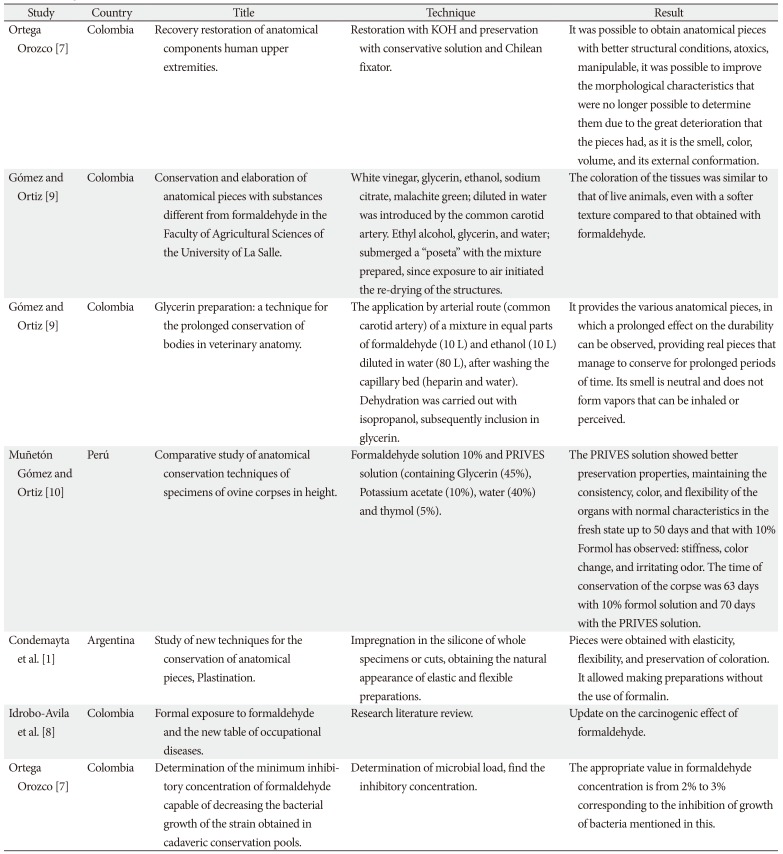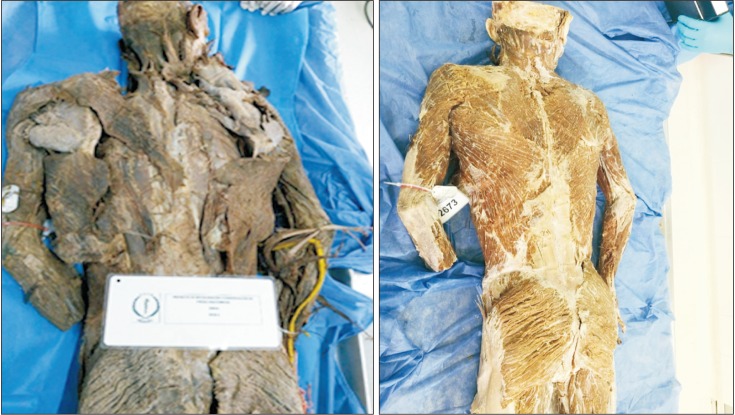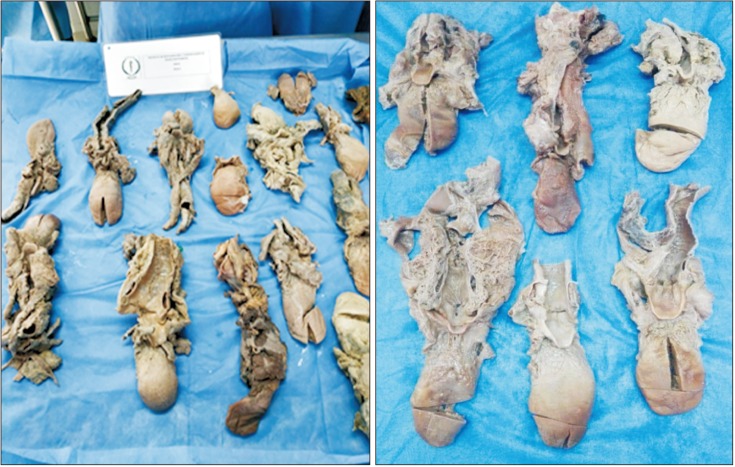Introduction
The decomposition is a process in which organic tissues disintegrate, this is due to the combined action of bacteria and microorganisms present in the bodies and the effects of the external environment. Formaldehyde has undoubtedly been the component most commonly used to delay the effects of decomposition in corpses; its main action is to react with protein amino groups, forming transversal links, and keeping the cell structure. It also acts inhibiting bacterial growth, which attributed its main role in the preservation of anatomical structures. However, thanks to various studies, it is well known that the replacement of formaldehyde by other conservative chemicals has no adverse effects on the natural decomposition process. The Chilean conservative fixative solution (SFCCh) doesn't eradicated completely formaldehyde, but it reduces its concentration within the solution; other methods of conservation show that the structures and specimens in which this technique is used, present improvements in the consistency, odor, color and growth of fungi with respect to formalin solutions, emphasizing that through the days the structures preserved with the method Prives have a minor decomposition compared to those treated with formaldehyde. This shows that formaldehyde is not the only compound capable of delaying decomposition in corpses and replacing it completely from the conservative solutions currently used does not represent a decrease in decomposition processes, on the contrary, can be more effective in the conservation [
1].
Formaldehyde is a compound of carbon, hydrogen and oxygen extremely reactive, that is shaped gaseous and aqueous, during various investigations post-mortem, it has been found several negative effects that formaldehyde has on the environment and mainly against the health of the people who handled it continuously, presenting a high level of toxicity, which can lead to various complications [
2].
Formaldehyde is listed in the International Agency for Research on Cancer (IARC) classification as a class 1 carcinogen, within the group of 107 agents with sufficient scientific evidence of causing cancer in humans. Until 2006, the formaldehyde was located in group 2A (probable carcinogen for humans), but in the 2006 IARC monographs volume 88, It already reaches the highest score as causal agent of cancer. In recent years the “officiality” of this carcinogenic effect has been collected in professional media, as well as informative; The website of the American Association of Industrial Hygienists (AIHA), disposes of abundant documentation on formaldehyde which contains the carcinogenic effect of this chemical agent. Also on the Web of the American Occupational Safety and Health Administration of the U.S. Department of Labor (OSHA), it's summarized the scientific evidence of formaldehyde as a causal agent of occupational cancer [
3].
To reduce the concentration of formaldehyde in the air inside the facility, it is recommended that the corpses remain in ventral decubitus to improve runoff of formalin and prevent its accumulation in the body cavities. Adopting other techniques of fixation and preservation of corpses, in order to avoid exposure to toxic substances and decrease the occupational hazard [
4].
For bodies which have already been preserved in formaldehyde, that have been deteriorated by use and the passage of time, as it is the case of the structures that were used in this project, was made use of substances such as KOH, solution saline and hypochlorite whose properties allow recover and highlight anatomical details that are fundamental for the study. In Chile, it was possible to create a solution that can stop the natural process of decomposition and favors a good conservation of the structures, since it is capable of maintaining the conditions of fixation over time, It can be used through intravascular injection or immersion. Within the benefits of the implementation of this method, is the lack of need for renovation and implementation of the use of pools of conservation, since it can be applied by spray, keeping constant conservation parts. In Colombia, it has had a favorable adhesion, having been tested in different institutions of higher education as, the University of Antioquia, University of Santander, University of the Bosque, among others. Additionally, referred to studies that confirm and valorize the results, in which it was concluded that it has been highly favorable in the processes of preservation of anatomical specimens for more than 2 years [
5].
As a goal it was proposed the restauration of a corpse at the disposal of the Amphitheater of the University in deteriorated state by the use and then it was set in Chilean fixative solution, in order to provide useful tools for the study of anatomy and prolong the results obtained with the first step (restoration) making use of the Chilean conservative and fixative solution.
Go to :

Materials and Methods
The databases used were, Elsevier, Science Direct, Pro-Quest, MEDLINE, and another additional sources, as academic Google, which provided some of the information for the elaboration of this project.
For the restoration process were used the following materials; which were acquired in Bogotá D.C, Colombia; Ciacomec S.A.S:
For the process of conservation with the SFCCh, we used the materials illustrated in
Table 1.
Table 1
Exact formula for the elaboration of the SFCCh

|
Volume |
|
Sodium chloride |
1,500 g for every 6 L |
|
Sodium, potassium or urea nitrate (>43%) |
1,200 g for every 6 L |
|
Glycerin |
6 L |
|
Ethyl alcohol |
4 L |
|
Benzalkonium chloride |
2 L |
|
Formaldehyde (2%) |
500 mL |
|
Essence of eucalyptus or citrus (lemon) |
500 mL |

Parts to restore were mainly: corpse No. 2673, hearts, stomachs, tongue, kidneys, and spleens. In addition, during the execution were available sponges, needles, thread nylon, dissection kit, Gramera, Baker, plastic bags, tape, plastic, wood, nails, hammer, saw, buckets, plastic containers, wire, and elements of biosafety.
Methodology
Within this work, dealt with the processes of restoration with potassium hydroxide (KOH) and conservation in SFCCh of a corpse and different anatomical parts existing in the Amphitheater for Sciences of the health of the University of Applied Sciences and Environmental (U.D.C.A). Based on Protocol the restoration of Dr. José Darío Rojas Oviedo during the course of plastination and anatomical techniques conducted by Dr. Yobany Quijano and the technical Duvan Ballesteros in the Faculty of Medicine of the University of Antioquia.
The project was developed in three stages:
(1) Stage 1: In this first stage was raised the idea and the main objective of the project; was carried out the purchase of materials and reagents needed for the restoration and conservation of the corpse as of the selected bodies.
(2) Stage 2: Was applied processes of restoration and preservation processes applied to the corpse and selected organs. During the restoration with potassium hydroxide, the following steps were followed:
Macerated: Consists of cleaning and softening the specimen with 1% to 2% potassium hydroxide diluted in water.
Degreasing: This stage is to remove the adipose tissue from the piece. It is used in first instance xylol but turns out to be very toxic, so it can be replaced by potassium hydroxide in concentrations above the previous.
Clearance: In this third stage, the specimen is completely manipulatable, at the end of performing dissections that are believed necessary, was applied sodium hypochlorite in the anatomical structures that are wished to be bleached, especially tendons, nerves, and ligaments.
(3) Stage 3: Analysis of the results observed after the restoration of the human specimen and in the restoration and conservation of organs.
Inclusion criteria are as follows: human specimen in a deteriorated state; damaged organs. And exclusion criteria are as follows: previously restored human specimens.
Restoration of human specimen
It was selected the corpse No. 2673 that had the following features: was in the pool No. 2 in the amphitheater, 35 years old, male, date of entry: July 26, 2001, donated by legal medicine in Bogotá D.C., Colombia.
Prior to the conservation of the human specimen, a drawer with wooden planks was elaborated, its dimensions were 2 m long and 64 centimeters in width, After this, KOH and NaCl were weighed to 2% respectively for the development of the restorative solution and finally added to the corpse; with a total expense of 180 L of KOH solution at 2%.
Later on, it was dipped in this solution for several days, where a daily checkup was made for the analysis of the structures that had improved their appearance, on the second day, a wash with a solution of KOH in one slightly higher concentration was made, and it was found, that some structures will require more time to achieve the desired look, finally, washed the corpse with saline (NaCl) in order to neutralize the action of potassium hydroxide.
After the above-mentioned process we proceeded to suture the regions with greater affectation, was used the thinner nylon thread to achieve optimal resistance, because a greater thickness presents difficulties for the resistance of the sutures performed in the tissues. Finally, we dipped the corpse in sodium hypochlorite, in order to remove any residue of KOH stored or integrated in structures.
Restoration and conservation of organs
Four containers in which they were selected: Container No. 1, 40 hearts; Container No. 2, 43 tongues; Container No. 3, 15 stomachs; and Container No. 4, 39 kidneys and spleens.
The structures previously distributed were submerged in different volumes of solution of KOH to 2% concentration. Where each group of organs had an expenditure of potassium hydroxide individually (
Table 2). After this step referred above, it was carried out cleaning of the organs with the use of saline solution and industrial sponges, with an approximate duration of 2 weeks, for the neutralization of potassium hydroxide and elimination of formaldehyde of structures, in this way guaranteeing the efficiency of the SFCCh.
Table 2
Total volume of KOH solution to 2% in the three cans of organs

|
Caneca |
Volume |
|
1 |
Hearts: 30 L KOH solution |
|
2 |
Stomachs and languages: 20 L KOH solution |
|
3 |
Kidneys and spleen: 10L KOH solution (each) |

Finally, was the preparation of 75 L of conservative Chilean fixative solution, for the four containers mentioned above; it was the exact measurement of each reagent with help from a Baker and buckets for the exact measurement of the reagents. The exact formula for the elaboration is in
Table 1.
The Chilean solution seeking to stop the natural processes of decomposition, while maintaining the conditions of fixation over time and the effectiveness of this, lies in each one of the components used for its production. Below, are intrinsic characteristics of each reagent; chloride of sodium (preservative), sodium nitrate (preserves colors), glycerine (inhibitor of the enzyme changes, preservative, softener and humectant), ethyl alcohol (dehydrates and degrades the dehydrates and degrades the adipose tissue), benzalkonium chloride (antifungal in high concentrations), formaldehyde (disinfectant and preservative in fresh biological samples), essence of eucalyptus (neutralizes the irritating smell of formaldehyde) [
6].
Go to :

Discussion
During the course of consultation of the different used items as a guide in this project, differing methods were identified for restoration as the preservation of anatomical parts, in the same shape similarities between them, especially the benefits afforded by the use of these solutions (
Table 3).
Table 3
Bibliographic comparison of techniques for restoration and conservation

|
Study |
Country |
Title |
Technique |
Result |
|
Ortega Orozco [7] |
Colombia |
Recovery restoration of anatomical components human upper extremities. |
Restoration with KOH and preservation with conservative solution and Chilean fixator. |
It was possible to obtain anatomical pieces with better structural conditions, atoxics, manipulable, it was possible to improve the morphological characteristics that were no longer possible to determine them due to the great deterioration that the pieces had, as it is the smell, color, volume, and its external conformation. |
|
Gómez and Ortiz [9] |
Colombia |
Conservation and elaboration of anatomical pieces with substances different from formaldehyde in the Faculty of Agricultural Sciences of the University of La Salle. |
White vinegar, glycerin, ethanol, sodium citrate, malachite green; diluted in water was introduced by the common carotid artery. Ethyl alcohol, glycerin, and water; submerged a “poseta” with the mixture prepared, since exposure to air initiated the re-drying of the structures. |
The coloration of the tissues was similar to that of live animals, even with a softer texture compared to that obtained with formaldehyde. |
|
Gómez and Ortiz [9] |
Colombia |
Glycerin preparation: a technique for the prolonged conservation of bodies in veterinary anatomy. |
The application by arterial route (common carotid artery) of a mixture in equal parts of formaldehyde (10 L) and ethanol (10 L) diluted in water (80 L), after washing the capillary bed (heparin and water). Dehydration was carried out with isopropanol, subsequently inclusion in glycerin. |
It provides the various anatomical pieces, in which a prolonged effect on the durability can be observed, providing real pieces that manage to conserve for prolonged periods of time. Its smell is neutral and does not form vapors that can be inhaled or perceived. |
|
Muñetón Gómez and Ortiz [10] |
Perú |
Comparative study of anatomical conservation techniques of specimens of ovine corpses in height. |
Formaldehyde solution 10% and PRIVES solution (containing Glycerin (45%), Potassium acetate (10%), water (40%) and thymol (5%). |
The PRIVES solution showed better preservation properties, maintaining the consistency, color, and flexibility of the organs with normal characteristics in the fresh state up to 50 days and that with 10% Formol has observed: stiffness, color change, and irritating odor. The time of conservation of the corpse was 63 days with 10% formol solution and 70 days with the PRIVES solution. |
|
Condemayta et al. [1] |
Argentina |
Study of new techniques for the conservation of anatomical pieces, Plastination. |
Impregnation in the silicone of whole specimens or cuts, obtaining the natural appearance of elastic and flexible preparations. |
Pieces were obtained with elasticity, flexibility, and preservation of coloration. It allowed making preparations without the use of formalin. |
|
Idrobo-Avila et al. [8] |
Colombia |
Formal exposure to formaldehyde and the new table of occupational diseases. |
Research literature review. |
Update on the carcinogenic effect of formaldehyde. |
|
Ortega Orozco [7] |
Colombia |
Determination of the minimum inhibitory concentration of formaldehyde capable of decreasing the bacterial growth of the strain obtained in cadaveric conservation pools. |
Determination of microbial load, find the inhibitory concentration. |
The appropriate value in formaldehyde concentration is from 2% to 3% corresponding to the inhibition of growth of bacteria mentioned in this. |

Different types of conservation techniques are illustrated in the different articles reviewed, they mention the decrease or elimination of formaldehyde, to make the least harmful solution since it promotes different conditions to those who have exposure or contact with substance. This compound is considered an oncogenic agent, according to data obtained from the article by the journal of public health volume 19, posted in June 2017 titled occupational exposure to formaldehyde and the new table of occupational illnesses, indicates that “in 2006, the International Agency for Research on Cancer and who published the classification of formaldehyde, that is considered within the substances carcinogenic in humans (group 1), which takes human insufficient data as evidence” [
8].
On the other hand, we found that the concentrations of formaldehyde used in swimming pools for the conservation of the human Amphitheater University of applied and environmental sciences U.D.C.A, they correspond to a high percentage, which corresponds to the 7.6%, representing high biological risk to handlers, adding to this the formaldehyde is responsible for the decrease in mobility in joints, change in color of the musculature of the bodies and over time it also contributes to its deterioration. Based on the above, we find different solutions in the literature that a complete restoration of the anatomical structures and others that allow us to fix them with a lower concentration of formaldehyde, achieving a better long-term conservation.
Considering the results obtained in the eighth Colombian Congress of morphology by Dr. José Darío Rojas Oviedo, the conservative fixative solution, he has shown good results in fixation, adequate conditions of preservation, preservation of flexibility in joints, muscles rather friable and similar in appearance to the observed post-mortem; preservation in animal tissues was found without greater deleterious effects on them, by paying the decrease of the irritant or toxic effects for those who manipulate them, improving the road to an investigative teaching without the discomfort of formaldehyde [
11].
Conclusion
To make the conservation of the anatomical parts making use of chemical substances, a significant improvement in terms of the presentation of tissues, could be observed, in the same way that the results obtained by Dr. José Darío Rojas Oviedo and others consulted authors who made use of these techniques for the restoration and conservation. the human specimen, when submerged in potassium hydroxide, renewed each of its muscles, therefore, its consistency and coloration gave it a more approximate aspect to reality, also, due to its subsequent washing in saline solution, it showed a decrease in the joint stiffness and greater mobility of these. On the other hand, the bodies being introduced in Chilean solution, evolved in terms of their tonality, giving them a less rigid appearance, in addition, following fixation, it was observed conservation of the results obtained after the restoration. We hope that the SFCCh will enable more durability in the conservation of these parts all in order to facilitate the study of Anatomy in anatomical structures. In the same way the use of this solution facilitates the manipulation of the anatomical parts and human specimens used in the academic practice decreasing considerably the toxicity to which people are exposed in constant interaction with formaldehyde.
Go to :






 PDF
PDF ePub
ePub Citation
Citation Print
Print







 XML Download
XML Download